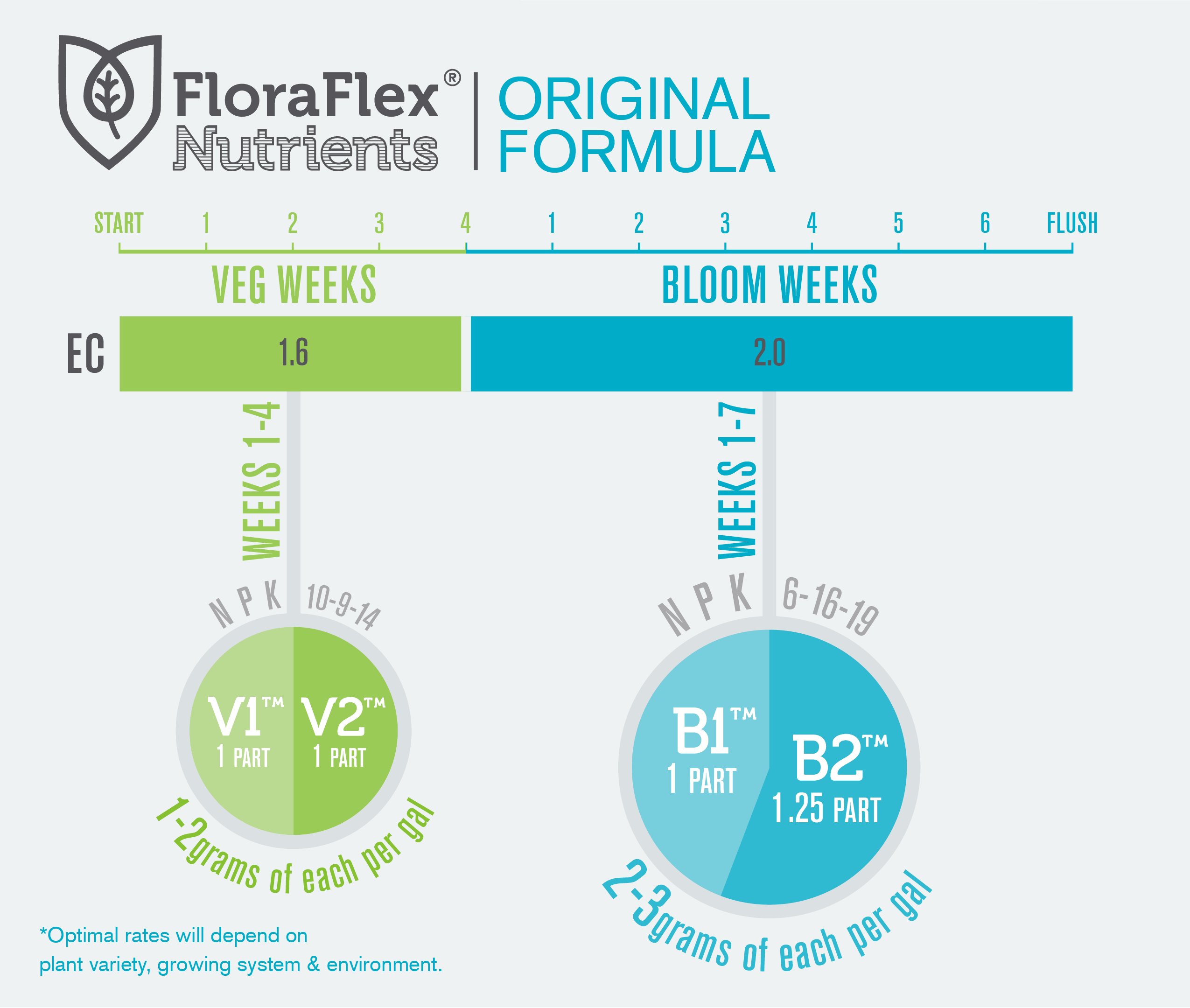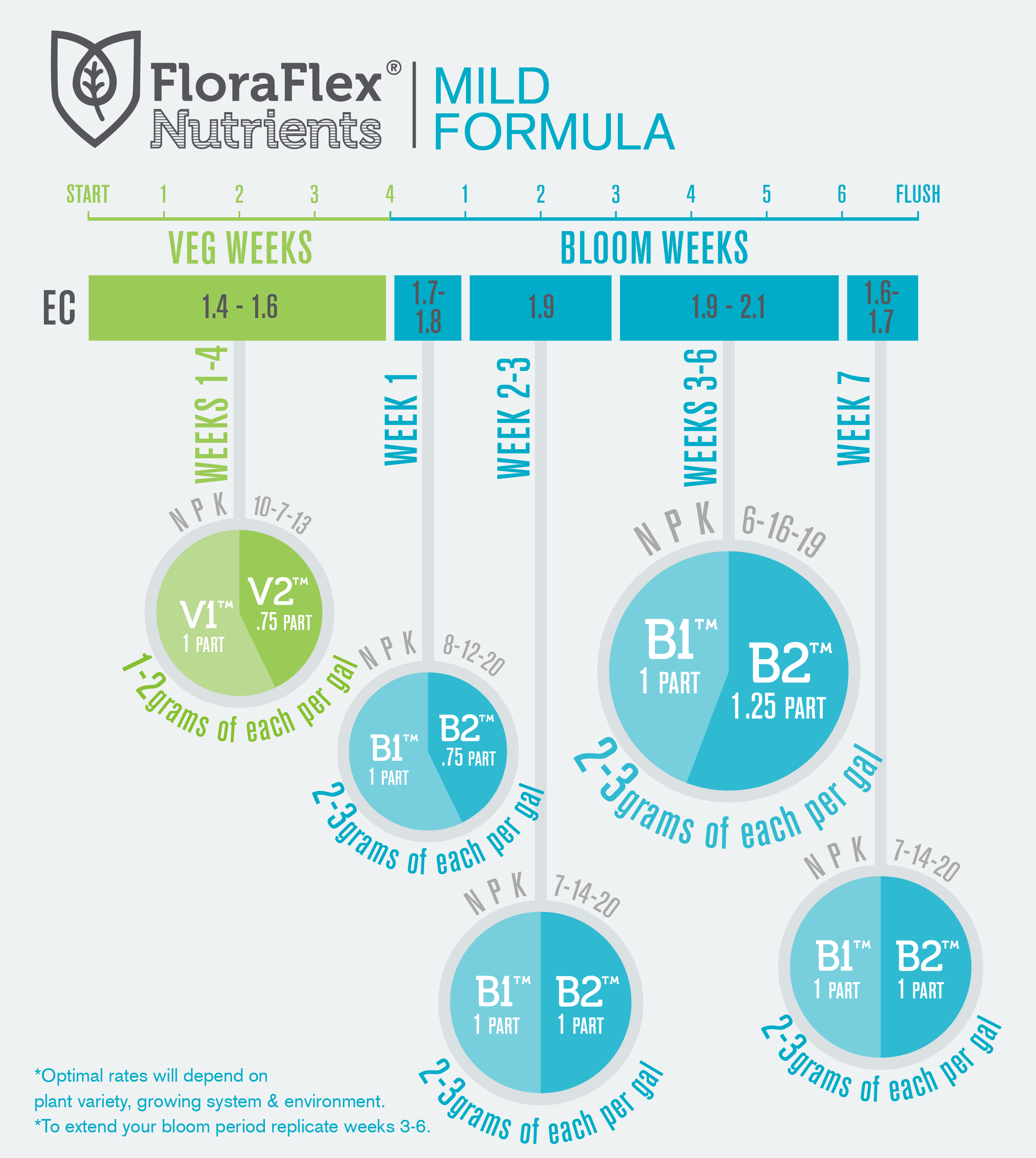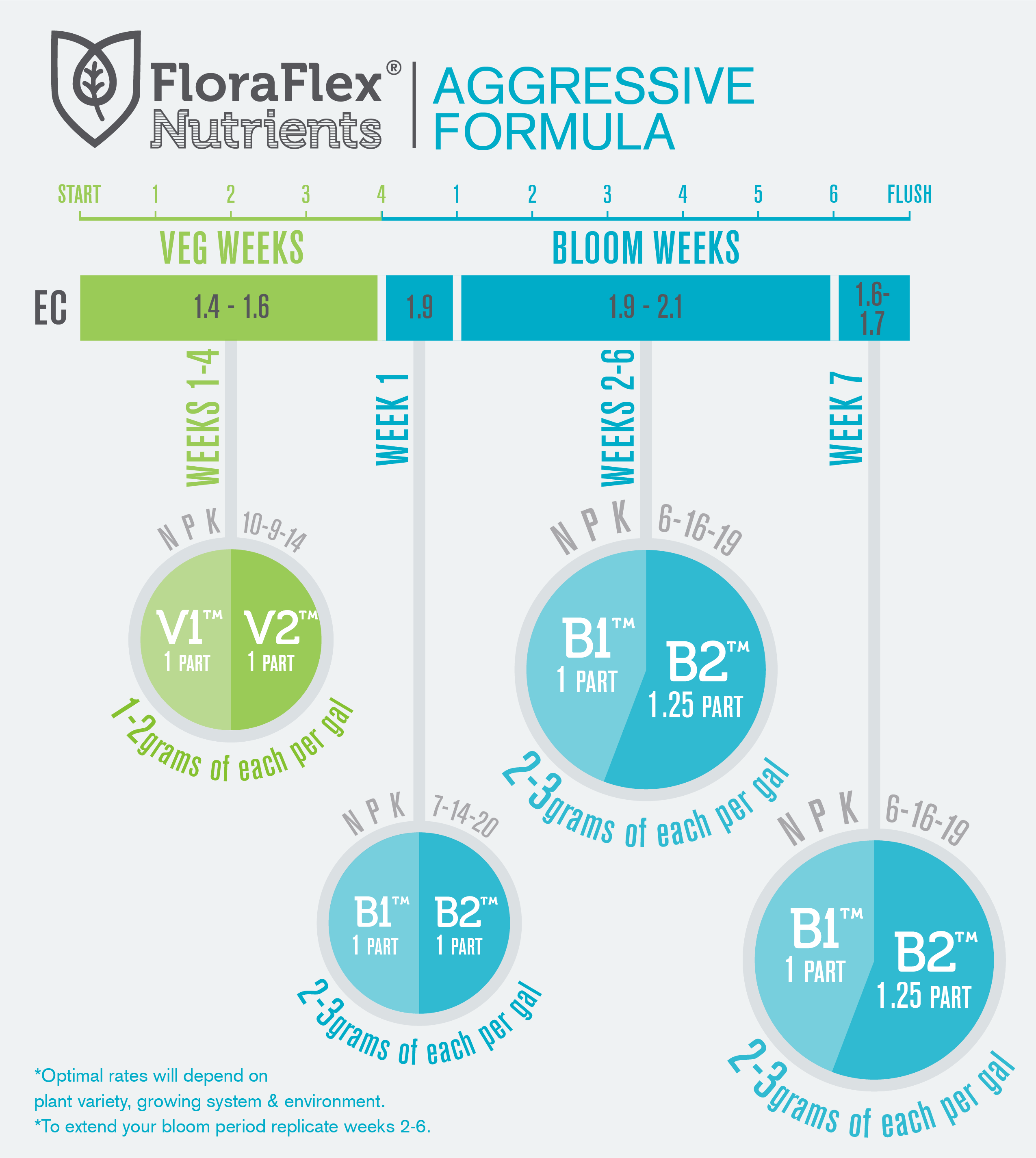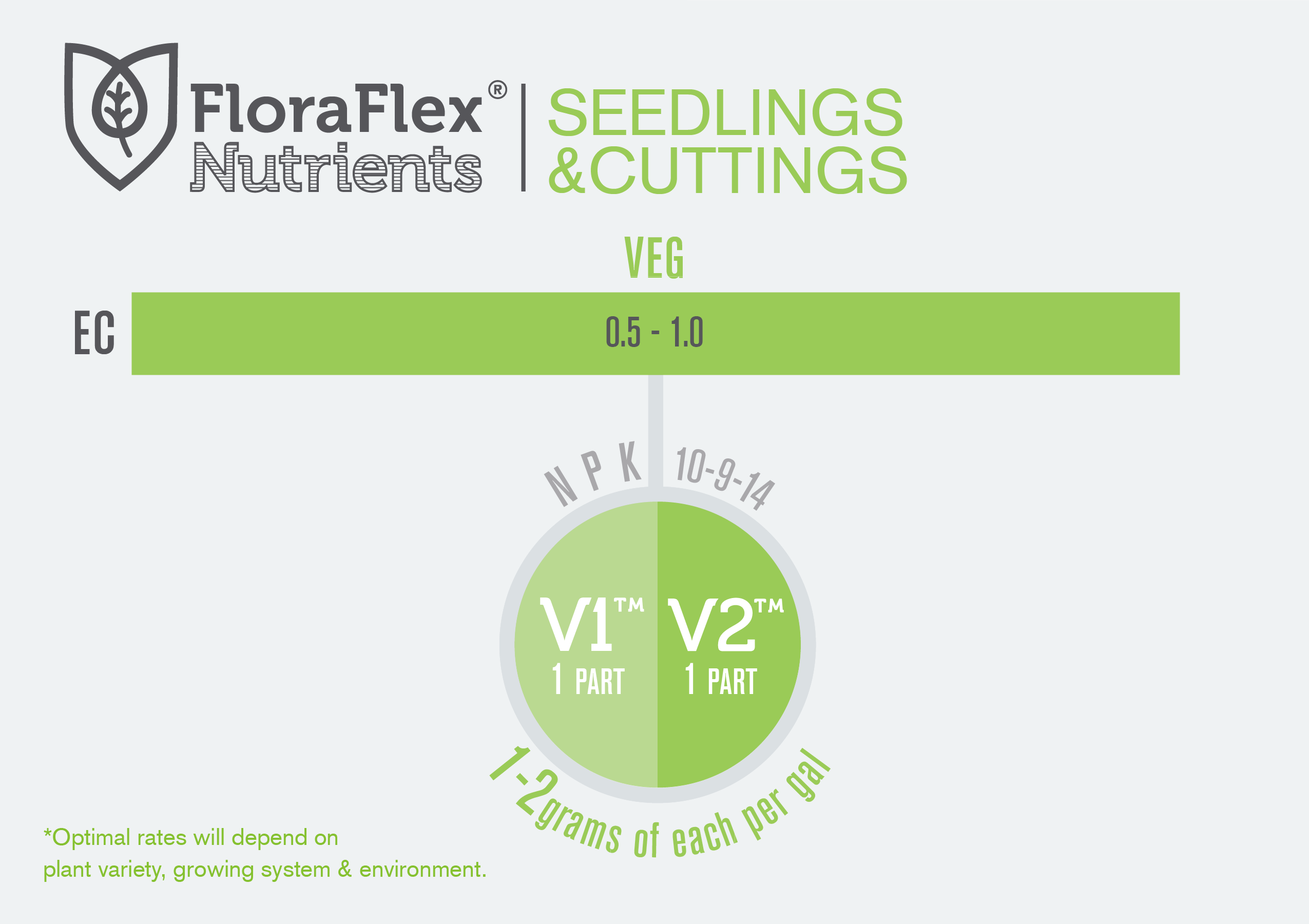Buying and using nutrients should be simple, honest, and cost effective. The nutrients for our favorite plant should include all of the essential elements, come in only a few or no bottles, and provide you with the ability to improvise and control the process. This is why we came up with a simple two part formula for both the Vegetative and Bloom stages. All of the essential elements included in these products have been documented for you to see. And, we made sure we sourced high quality elements at the best pricing available so we could pass those savings on to you. For more info on how the first FloraFlex Nutrient line evolved, read our story.
Feeding Schedules
Throughout time many of us within our community have ran our own nutrient formulas, and there is a very common theme among many successful growers: keep a simple and consistent regimen throughout both the Vegetative and Bloom cycles. This concept is the basis of our Original Formula Chart.
But, because of the many varieties of strains we grow, environments we grow in, and methods we use, or have become accustomed to, other successful growers like to mix things up, which is why we have listed three additional charts. The Mild, Aggressive, and Super Aggressive charts were created for those of us who have adjusted, or like the ability to be able to adjust, our formulas at certain stages throughout our plants’ lives. Within these charts you will see six different combinations in which these formulas can be applied, see below:
For Vegetative
1. 1 part V1™ to 0.75 parts V2™ (N P K / 10 – 7 – 13)
2. 1 part V1™ to 1 part V2™ (N P K / 10 – 9 – 14)
For Bloom
3. 1 part B1™ to 0.75 parts B2™ (N P K / 8 – 12 – 20)
4. 1 part B1™ to 1 part B2™ (N P K / 7 – 14 – 20)
5. 1 part B1™ to 1.25 parts B2™ (N P K / 6 – 16 – 19)
6. 1 part B1™ to 1.50 parts B2™ (N P K / 5 – 17 – 19)
For what these parts do specifically see our Essential Elements page.
As always at FloraFlex we want to provide you with the tools of improvisation and control, and feel that within the different possible ratios presented above and throughout these charts you may adjust and find what works best for you.
Mixing Instructions
V1 & V2
• First Mix V1 in your water source, allow it to completely dissolve. Then add V2.
• Depending on your desired EC use 1-2 teaspoons per 5 gallons of water
(1-2 grams per gallon)
• Add V1 and then V2 to your water source throughout the entire vegetative stage.
• At lower dosages V1 and V2 can be used as a base along with other additives.
B1 & B2
• First Mix B1 in your water source, allow it to completely dissolve. Then add B2.
• Depending on your desired EC use 1-3 teaspoons per 5 gallons of water
(1-3 grams per gallon)
• Add B1 and then B2 to your water source throughout the entire flowering stage.
• At lower dosages B1 and B2 can be used as a base along with other additives.
– All formulas are meant to have a starting water EC of 0.2 – 0.3, you can get up to, but should not exceed, an EC of 0.7 – 0.8. If you are using RO water with an EC of 0 then bring your EC up to 0.2 – 0.3 by adding hard/tap water, a Cal-Mag, or Epsom Salt. Pure water with no dissolved salts has no buffering capacity and therefore the pH is difficult to predict or control. Blending in some municipal water usually adds a little bicarbonate which gives a little buffer capacity to the water making pH control easier.
– While the pH of your fertilized water going into the medium is important, many agree that the water inside and/or coming out of your medium/drain water, what the roots are uptaking, is of the utmost importance. The pH of your drain water should be maintained between 5.3 – 6.3 to maximize your plants ability to absorb the necessary nutrients. Our nutrients have been tested in different water sources and mediums, and were found to consistently remain between these optimized levels.
– If you are utilizing other additives with no NPK values then you will keep the amounts of suggested rates. But if you are adding other additives with NPK values, you should decrease the amount of FloraFlex Nutrients. Keep in mind we have formulated these blends to not need any additional NPK value.
– Some growers flush weekly in Bloom, others do it a few times on designated days (before and/or during traumatic or stressful occurrences such as defoliation), while some only flush when they see the plants starting to show signs of excess salt build up within the medium or stress signs from their plants, such as the edges of the leaves spiking up. If and or when you flush use a lower ratio of fertilized water between 0.7 – 1.0. Ideal water temperatures for your fertilized water are in the range of 60° – 75°.
– All Micronutrients will be found in parts 1. If you ever experience micro deficiencies scale back like the Mild Formula to the ratio of 1:.75 until your plants look healthy again. The first week of Veg and the first of Bloom should do the trick if you have issues.
Formulas and Charts
Original Formula:
This method reflects the knowledge of horticulturists who have worked for decades with our favorite plant in greenhouses, outdoor farms, and indoor facilities with great results. Because of the scale of their operations, they prefer to have a simple and consistent two part regimen, with the right nutrient formula that already includes all of the essential elements for healthy plant growth. Click on image to download PDF.
Mild Formula:
This is a toned down version of our Original Formula, and provides more Nitrogen (see benefits here) than any of our other charts, while still providing all of the other necessary elements they need to thrive. The Mild schedule came on the advice of the traditional horticulturists we work with, they believe most fertilizers for our favorite plant overuse phosphate and potassium, and therefore recommend this conservative approach.Click on image to download PDF.
Aggressive Formula:
This chart is very similar to the Original Formula but is for people who like to give their plants extra Nitrogen in the first week of bloom knowing that plants process the majority of the nitrogen they need within the first half of their lives. Click on image to download PDF.
Super Aggressive Formula:
This chart is for people who really like to push their plants in the middle of flower with extra bud enhancing nutrients which are made up of mostly phosphorus and potassium. We suggest you only use this after trying the Aggressive Chart and feel that your plants can or could use a little more of these two elements. Click on image to download PDF.
Seedlings & Cuttings:
Many of us use strictly pH water when planting seeds or cuttings until they root, at which time we begin adding nutrients. But some start with a very low dosage of nutrients. This chart helps you with either. Click on image to download PDF.









